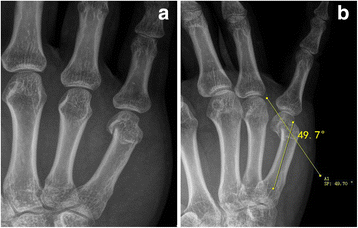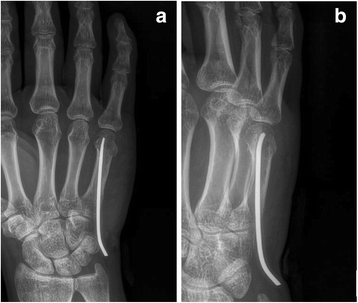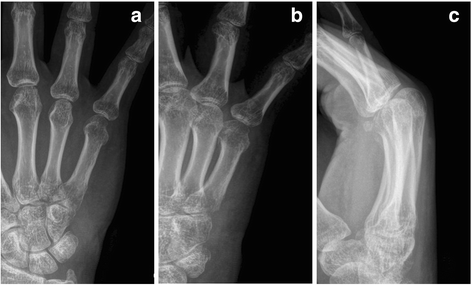Treatment of fifth metacarpal neck fractures with antegrade single elastic intramedullary nailing
- PMID: 28577350
- PMCID: PMC5457582
- DOI: 10.1186/s12891-017-1592-3
Treatment of fifth metacarpal neck fractures with antegrade single elastic intramedullary nailing
Abstract
Background: The aim of this study was to investigate clinical outcomes of fifth metacarpal neck fractures using antegrade single elastic nail and to explore ideal puncture point to avoid iatrogenic ulnar nerve injury.
Methods: A single elastic nail with suitable diameter was used in 27 cases of fifth metacarpal neck fractures with dorsal angulation over 45°. An initial entry point was perforated at the ulnar-dorsal base of the metacarpal. The nail was inserted in an antegrade approach. The nail was usually removed at about 5 weeks postoperatively.
Results: At final follow up, all fractures proceeded to bony union. The mean total passive motion was 285° and the mean total active motion (TAM) was 270°. The mean angulation decreased from 50.2 ± 6.3° preoperatively to 7.4 ± 2.3° postoperatively (p < 0.001). The mean DASH-Score was 2.1 ± 3.6 points after surgery. Two cases of skin irritation and one case of the dorsal cutaneous branch of the ulnar nerve (DCBUN) injury were observed. Superficial wound infections were not observed.
Conclusions: Collectively, antegrade single elastic intramedullary nailing was a minimally invasive and reliable fixation technique for fifth metacarpal neck fractures with dorsal angulation over 45°. Appropriate puncture position helped to reduce nerve damage.
Keywords: Antegrade single elastic nailing; Fracture; Metacarpal neck; Surgery.
Figures



Similar articles
-
Antegrade intramedullary pinning versus retrograde intramedullary pinning for displaced fifth metacarpal neck fractures.Clin Orthop Relat Res. 2015 May;473(5):1747-54. doi: 10.1007/s11999-014-4079-7. Epub 2014 Dec 11. Clin Orthop Relat Res. 2015. PMID: 25502343 Free PMC article. Clinical Trial.
-
Fractures of the neck of the fifth metacarpal bone, treated by percutaneous intramedullary nailing: surgical technique, radiological and clinical results study (28 cases).Pan Afr Med J. 2014 Jul 4;18:187. doi: 10.11604/pamj.2014.18.187.3347. eCollection 2014. Pan Afr Med J. 2014. PMID: 25419314 Free PMC article.
-
A minimally invasive fixation technique for selected patients with fifth metacarpal neck fracture.Injury. 2016 Jun;47(6):1270-5. doi: 10.1016/j.injury.2016.01.034. Epub 2016 Feb 11. Injury. 2016. PMID: 26971086 Clinical Trial.
-
Antegrade intramedullary nailing for fifth metacarpal neck fractures: a systematic review and meta-analysis.Eur J Orthop Surg Traumatol. 2014 Apr;24(3):273-8. doi: 10.1007/s00590-013-1344-5. Epub 2013 Oct 27. Eur J Orthop Surg Traumatol. 2014. PMID: 24162582
-
Intramedullary fixation of unstable metacarpal fractures.Hand Clin. 2006 Aug;22(3):269-77. doi: 10.1016/j.hcl.2006.02.016. Hand Clin. 2006. PMID: 16843793 Review.
Cited by
-
Antegrade intramedullary fixation for adolescent fifth metacarpal neck fracture and its impact on epiphyseal growth.BMC Musculoskelet Disord. 2021 Jun 15;22(1):546. doi: 10.1186/s12891-021-04436-w. BMC Musculoskelet Disord. 2021. PMID: 34130660 Free PMC article.
-
Iatrogenic Injuries in Percutaneous Pinning Techniques for Fifth Metacarpal Neck Fractures.Hand (N Y). 2019 May;14(3):386-392. doi: 10.1177/1558944717731858. Epub 2017 Sep 21. Hand (N Y). 2019. PMID: 28933198 Free PMC article.
-
Early movement does not cause loss of reduction in surgically treated boxer fractures.Ulus Travma Acil Cerrahi Derg. 2022 Aug;28(8):1142-1147. doi: 10.14744/tjtes.2021.24668. Ulus Travma Acil Cerrahi Derg. 2022. PMID: 35920419 Free PMC article.
-
Single versus dual elastic nails for closed reduction and antegrade intramedullary nailing of displaced fifth metacarpal neck fractures.Sci Rep. 2021 Jan 19;11(1):1778. doi: 10.1038/s41598-021-81242-3. Sci Rep. 2021. PMID: 33469102 Free PMC article.
-
Single Buried Intramedullary K-Wire Fixation in Nonthumb Metacarpal Shaft Fractures with Immediate Postoperative Mobilization without Any Immobilization.Adv Orthop. 2023 Oct 16;2023:1439011. doi: 10.1155/2023/1439011. eCollection 2023. Adv Orthop. 2023. PMID: 37877095 Free PMC article.
References
-
- Freeland A, Geissler W, Weiss A. Surgical treatment of common displaced and unstable fractures of the hand. Instr Course Lect. 2002;51:185–201. - PubMed
MeSH terms
LinkOut - more resources
Full Text Sources
Other Literature Sources
Medical

